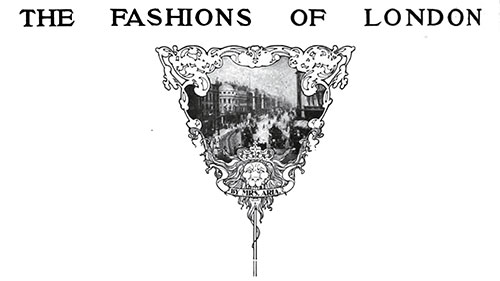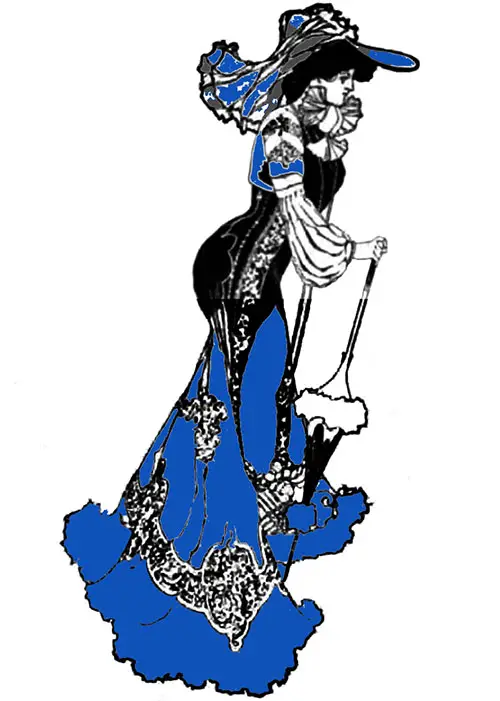London Fashions October 1903

Blue wins; other colors have been struggling, and as always during the Autumn time plaid has many devotees, but undoubtedly the color of the season is blue.
Very smart evening dresses—and I suppose one may suggest evening dresses in the full view of an early Autumn season —are made in a bright shade of sapphire blue, the chiffon of our many years' delight being again the idol of the hour.
Blue is the color chosen for the cloth costumes, and, again, the prettiest of blue hats may be seen worn in combination with black cloth dresses.
Black cloth dresses, above all others, are the most desirable, and entire costumes consisting of bodice of cloth and skirt of cloth have much of the attention of the authorities, who endeavor to woo us by a simulated easefulness, thin linings, and loose sleeves, from the comfort of the blouse of lace.
Yet in spite of such temptations, the lace bodice of the deepest string tone will be chosen by many as the accompaniment to the black cloth coat and skirt.
Such a pretty black cloth coat I have seen piped with a black and white striped silk crossed with a line of red, the effect being scarcely that of a check yet not entirely that of a stripe, and red spots at long intervals added to the attractiveness of the silk, which besides forming the pipings formed the lining to the little jacket.
The latter bore a deep cape collar cut into points with large tassels of silk and chenille. A black hat with one ostrich feather shading from black to red completed the scheme, which may be voted a worthy one.
The same idea could be successfully copied in a dress of brown cloth—and brown shares, to a certain extent, the popularity of blue.

Ladies Day costume in Sapphire Blue (Color Added for Emphasis)
Here we have the three favorite aspects of the ordinary everyday costume—brown face cloth in combination with black and white, black with a vivid shade of blue, and the green plaid dress or the black and white check tweed; however, the green plaid is undoubtedly more suited to the chill, dark days which the advancing calendar leads us to expect.
Besides the black walking costume let me strongly commend everyone to the immediate purchase of a black evening dress. I am hoping that this year will see a revival of the black satin frock; silks have been too long out, and we should see that they get their chance.
Of course, for the very young girl the net or chiffon dress is infinitely more suitable, but young matrons—and most people are young matrons up to the age of fifty—should walk in silk attire, or dance, if they must.
The satin chosen for the gown need not be of the Duchesse kind, although I confess to much prejudice in favor of it. That softer fabric known as English satin by some, as Oriental by others, may be selected by those who prefer its clinging grace, and the bodices of all black satin dresses should for better becomingness show a profusion of ecru lace.
Excellent results may be achieved on the comparatively slim figure by a gathered skirt—and the full skirl grows daily in popularity— made of the soft satin with the hem trimmed with roulades of satin, and a deep corselet belt of satin revealing a low bodice of fine net with a ring spot, and an inner tucker of fine lace being threaded with black velvet ribbons.
The exact position of the drapery of the full net bodice will depend necessarily upon the shape of the shoulders of the wearer; some may look better in a fichu than in a collar, and others should be recommended to hold fast to the bébé outline.
There is much talk, but little accomplished, I fancy, in the direction of a general reform in costume, and many of the old plates of that period when the waist was an unconsidered quantity are being seriously consulted to see whether their charms could be transferred to our days with advantage.
To the tall woman, the Empire outline of a short bodice and long skirt lacks perhaps special advantage: to her that is short yet slender its effects are certainly beneficial.
It would be well if men, who are the main agitators on the question of reform in woman's clothes, would divest themselves of the idea that women wear corsets entirely to give them the opportunity of tight lacing.
We mostly wear corsets because it is impossible for us to be comfortable without some support to our backs; why this should be, when in the earliest days of the earliest centuries the unlined drapery sufficed, I confess I cannot explain, but it is largely true of today that the woman who goes without her stays will suffer after a few hours from a pain in her back and a general listlessness and want of vital energy.
The Autumn millinery should have claimed my attention before. Amongst the plainest hats that known as the French sailor in felt trimmed with a scarf with pendant tassels seems to have been adopted by very young girls.
The narrow Glengarry toque decked with ruches of velvet is amongst the other noteworthy models as well as the black hat trimmed with the shaded ostrich feather that I have mentioned; then, again, we have the toque made of flowers, chrysanthemums, Virginia creeper leaves, and dahlias being seasonably appropriate.
Perfectly plain hats of fine soft felt have as their sole decoration an enormous bird, and the prettiest of these which I have seen is made in brown with the bird in a vivid shade of orange, a small orange velvet bow being placed under one side of the front. Orange velvet, by the way, also struck a pretty note of color on a dark-brown dress with pipings of black and white.
Shaded effects in silk for belts, for hats and bodices, are noteworthy revivals, but somehow or other these shaded silks never seem to last long in our affections; yet if manipulated by the hand of the artist, and the dark portion of the silk kept near the waist, they may help us to arrive at artistic and becoming results.
And as I said before, the shaded ostrich feather is amongst the prominent extravagances of the millinery moment; when, too, may be recognized our old friend lophophore, the breast of the peacock really, forming some of the feather toques which as ever appear at this time.
Aria, Eliza Davis (Mrs. Aria), "The Fashions of London" in The Delineator: An Illustrated Magazine of Literature and Fashion, Paris-London-New York-Toronto: The Butterick Publishing Co., Ltd., Vol. LXII, No. 4, October 1903, Page 500.
Note: We have edited this text to correct grammatical errors and improve word choice to clarify the article for today’s readers. Changes made are typically minor, and we often left passive text “as is.” Those who need to quote the article directly should verify any changes by reviewing the original material.

